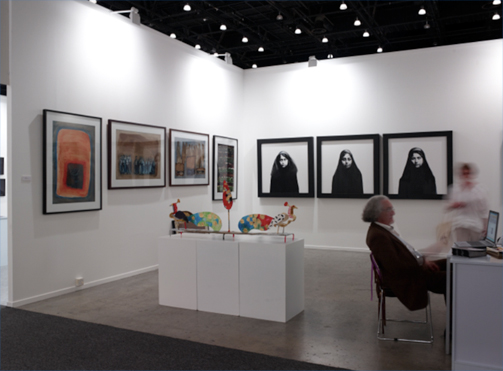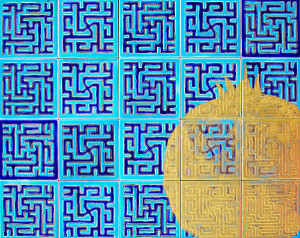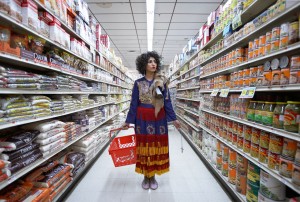
Image:Silk Road Gallery stand at Art Dubai 2009
The presidential election in Iran was hotly anticipated to be a turning point in the country as it falls on the 30th anniversary of the Iranian Revolution. Many have speculated on possible outcomes: could this mark another “colour” revolution, responding to a groundswell of a dynamic young population whose desire for an outlet for their creative and social energy has led to innovations in the country’s practices in media and visual culture? Or would there be a further entrenchment into the social and political isolation that has been associated with the Islamic Republic over the past three decades? The volatile response to the election results is indicative of the quiet desperation of a country caught between history, religion and politics. Though the sentiments of “a dream deferred” continue to simmer in the country, the momentum of cultural dialogue gains more traction among the supporters of Mir-Hossein Moussavi, a former prime minister who is known among the artistic communities through his support of the arts. “He spent all his time with artists, which is why they all support him,” said film-maker, Moshen Makhmalbaf, He is one of a number of prominent Iranian artists to have campaigned for Mr Moussavi.
The popularity of works of art created by Iranian artists spans an age before the 1979 Revolution;, however the rise of globalisation and multiculturrualism has influenced international art markets and are levelling the boarders in the art world. The current events in Iran today reflect the importance of alternative channels for dialogue from within Iran to the international community. The growth of the Iranian art market in the Middle East and Europe can be viewed as a new form of cultural diplomacy.
Over the last three years the international art world has witnessed a golden age for Iranian art. Artists from Iran have defined their presence as strong performers in terms of auction sales and exhibition profiles. Iranian artists have benefited considerably from this flowering art market as the UAE, Dubai in particular, serves as a platform to the global art market for Iranian artists because of the emirate’s position as a crossroads between Middle Eastern and Western professionals and commercial activities. The political isolation and limitations of an authoritarian government makes access beyond borders challenging for artists based in Iran, which affects the prices as well as the demand for Iranian artists at home and abroad.
The economic prosperity of the UAE formed the foundation for cultural development in Dubai, and with the arrival of three international auction houses and a proliferation of art galleries, it is currently leading the region into international art circles. The first editions of Dubai’s Gulf Art Fair (now re-branded as Art Dubai), haves invited established and emerging galleries from around the world to participate in what is now the largest art event in the Middle East. Galleries from the Middle East generated most of the sales, yet Western galleries also made significant sales. The presence of galleries from established art centres in Europe and America granted market validation and exposed international clientele into the Middle Eastern art scene.
Art Dubai director, John Martin, is planning for greater focus on Middle Eastern art in the future. The proliferation of art-related events in the Gulf testifies to the fertile market for collectors and art enthusiasts living in the region and for cultural consumption and tourism. Even fringe fairs are gaining traction with the Bastakiya Art Fair operating on the heels of Art Dubai. Nevertheless, the first Gulf art event was the Sharjah Biennial. Established in the early 1990s, the Sharjah Biennial had been on the radar of art insiders for years, showcasing Middle Eastern and International contemporary art insiders long before the Indian art boom made non-Western contemporary artists “ones to watch”.
In the meantime, auction houses currently operating in the area have sold works by modern and contemporary artists from the Middle East, North Africa and South Asia (MENASA) region and proved successful in fostering growing demand as well as establishing prices for works. The financial strength of the UAE has attracted a large number of Iranian nationals, many of whom represent mainly modern and contemporary Iranian art collectors who are keen to show pride and interest in their artists’ compatriots. However the Persian Diaspora is not the only barometer of the activities of the Iranian art scene and its performance on the market. The internal factors of Iran’s art market also influence the outcomes in the wider art world.
To analyse the Iranian art market, it is important to gain insight into a complex social history. Auction records have boosted domestic interest in works by domestic artists. Prices of works are rising despite oil prices dropping. Young Iranians, many educated abroad, are returning home with a hunger for contemporary art. Though the epicentre of the latest Iranian “art-quake” in the international art market is in Dubai, rather than Tehran, it is important to bear in mind Iran’s rich cultural history and mystery that has nurtured the creative spirits of the artists who are now, or soon will be, household names from Dubai to New York. Generations of Iranian artists have drawn inspiration from their past and present in order to produce creative dialogues in the visual arts. Knowledge of modern Iranian art is lacking in the west but not completely unknown. Paintings by Tehran-born Abstract Expressionist Kamran Katouzian (b. 1941, Tehran) are in the Museum of Modern Art, New York, as are sculptures by Parviz Tanavoli (b.1937, Tehran), who made his record breaking Dubai auction debut in April 2008 with the sale of The Wall (Oh Persepolis) for $2.8 million (incl. premium) at Christie’s. The auction houses are making superstars out of Iranian artists, with Farhad Moshiri (b. 1963, Shiraz) becoming the first artist from the Middle East to sell a work of art at auction for over $1 million.
The ties between Iran and Dubai are among the strongest in the UAE. Dubai has the largest concentration of Iranian expatriates in the region with about 9,000 part-Iranian-owned firms registered with the Dubai Chamber of Commerce and Industry. Iran is the main destination for exports from Dubai. The “Dubai Effect” of international exposure through auctions and art fairs leave Iranian artists hopeful that they can develop enough impetus to develop and maintain international cultural links to fellow artists, curators and organisations in other countries. During Mohammad Khatami’s presidency (1997-2005), artists benefited from the removal of restrictions requiring artists to obtain permits to exhibit their work at local galleries. Fine art education still persisted in the form of the master-apprentice relationship.
The first auction house in Dubai was Christie’s. Originally, projected sales were in the region of $30 million in three years when they first opened their office in 2005. According to a recent report on the Middle East modern and contemporary art market by ArtTactic, The volume of sale of Arab and Iranian Art has increased from $2 million in 2006 to $35.7 million in 2008. Iranian artists have dominated the Modern and Contemporary Arab and Iranian auctions (74% at Christie’s and 64% at Bonhams). The structure of cultural and market value for art in the Middle East is the invesrse of Western art markets. For example, in Europe and America, museums and public arts institutions serve as a cultural preserve with the power to validate an artist’s creative virtuosity. The public institution, especially the non-for-profit institution, is priced out of participation in the art market. The public sector provides an emblematic value by leveraging credibility to art and artists, it also prevents, through selection and in conjunction with the commercial art world, the market from becoming overloaded, a situation that would lead to a fall in art’s economic value. There is a large gap in the sophistication of international art markets and the domestic market in the Middle East.
Journalist Sohab Mohebbi describes the current state of the commercial art scene: The Iranian art scene still lacks professional workers-gallerist, advisors, and so on. The lack of constructive arts criticism leaves only news of auction records, prices, and money. A safeguard against this possibility lies in the continued work of the Tehran Museum of Contemporary Art. Founded in 1977 it is little known that the Museum holds one of the finest collections of Post-Impressionist, Modern and Contemporary art outside the Western art world. The last Empress of Iran, Farah Diba Pahlavi, founded the Museum. A passionate arts patron, she worked with foundations and advisors to amass an impressive art collection during a time when prices for works of art were on a decline. In 2007 the Imam Ali Museum opened to showcase contemporary art inspired by Islamic art. The rich collection of ancient, modern and contemporary art and new found recognition of local talent can provide an ideal template on which to support a rising art market by encouraging critical analysis and reflection within the artistic community and among art world professionals.
Like the Emirates itself, the region’s art market developed through clever economic planning and innovation. At the top of the cultural hierarchy are not the arts institutions but the auction houses. The auction house was the next step as many expatriate residents come from western art market regions (US, UK, EU) that already have a long history of art collecting and trading and have disposable incomes from highly paid finance and investment professions. After the auctions and the art fairs. The museums are next in the emerging market cultural hierarchy. Museums such as the recently opened Qatar Museum of Islamic Art have the potential to provide educational opportunities to inform the public about their creative history as well as giving contemporary creative ideas and further expanding the cannon of art history to a diverse generation of collectors and enthusiasts.
The promising rise of the Gulf economy has at last provided a stage for Iranian talent in Dubai’s growing consumer market for art, antiquities and design. The concentration of Iranian nationals resident in the region provides a welcome audience for art business, museums and institutions. By taking note of potential pitfalls associated with speculation that threaten the Indian and Chinese markets, Iran can draw upon it long and rich history of arts appreciation to support contemporary Iranian art for future generations and produce a fresh canon in art history.
Via:(www.artdubai.ae/journal)






